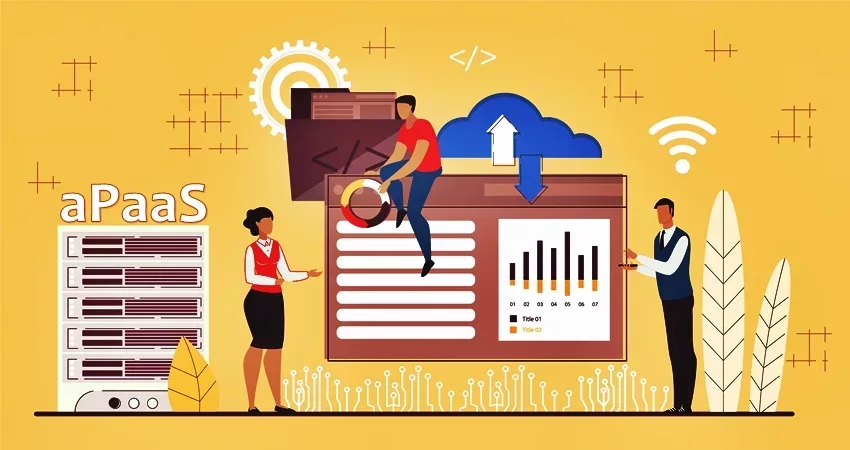As the digital space moves more towards the cloud, enterprises are opting for cloud services more often than not. The majority of these organizations are small and medium enterprises. Lack of upfront capital and hard-to-come investment has its own set of challenges. Not being able to procure the requisite tools for the business can be killing. In these times, when resources are at a premium, aPaaS (Application Platform as a Service) product comes as a savior.
They provide MSMEs the flexibility and capability to conduct smooth business operations without much investment. So what is aPaaS?
Cloud computing gives users access to shared and customizable resources. It allows developers and users to use the infrastructure and services that otherwise would have been tedious and expensive to set up.
It is similar to subscribing to Netflix or Hotstar to use their services online. The users need not install the hardware and software required for application development.
Application platform as a Service or aPaaS offers complete application lifecycle support to the users.
It provides users with an environment that supports application services from development to deployment, and everything in between.
This single platform enables developers to design, build, test, and deploy their applications, all on one platform. It improves speed, cooperation, and control over the entire lifecycle.
aPaaS is characterized by rapid application development and low code tools. This implies that the amount of coding knowledge required to design and build apps is reduced considerably.
From a business perspective, aPaaS allows developers to design apps with much fewer efforts. This improves their efficiency and creativity.
The global market for aPaaS has been on the rise continuously. A major factor for this being its ability to support enterprise-level projects. Disaster recovery, data security, and technical support also contribute to its growing popularity.
Enterprises are also opting for it more because aPaaS brings a whole world of possibilities for them, which we shall see ahead.
Both aPaaS and PaaS come under the same family of anything as a service (XaaS). The terms are often used interchangeably as the difference between them is slight. However, here is how you can distinguish them:
PaaS provides developers with the tools required for application development over the internet. It encompasses services such as operating systems, execution environments, application deployment platforms, etc.
aPaaS can be said to be a subcategory of PaaS. It encompasses only the services that are required for application development. It does not include other services that come under PaaS.
Also Read: BaaS vs. FaaS: Explaining the Two Serverless Architectures
Implementing aPaaS greatly improves the speed of development as well as deployment. The developer gets a ready foundation to start working with.
Rapid application development tools can be used as well to design the application. This would further speed up the development and deployment process.
It is not possible to predict when your system might need scaling up with the fast-paced world today.
For this reason, aPaaS systems were built to accommodate these growing requirements.
The platform allows you to select a new deployment option to suit the changing requirements of your system.
With aPaaS, issues such as reconfiguring the system, and improving data security are the least of the developer’s concerns.
aPaaS applications let you design, test, and refine your system iteratively. It enables you to make changes to the system in increments following the agile methodology.
It is easier to deploy your application since the changes to your application are made in increments.
Having all your data and services on one platform helps improve the efficiency of your system.
It also enhances the efficiency of the development teams. The developers have to worry less about pulling the data from various sources.
This enables better visibility in the applications. It makes the control and maintenance of the applications easier, thus saving time and effort.
Top aPaaS Vendors in the Market Today
According to a report by Gartner, the low-code application is expected to be about 65% of the global development industry.
Moreover, the market is expected to witness a substantial rise in the coming years. All major players in the application development market are launching their aPaaS services.
Following are some of the major players in the market today:
Mendix’s aPaaS solution provides you with a wide array of integrated tools for application development.
Designing app using the Mendix aPaaS platform does not require extensive UI designing skills.
Mendix lets you integrate your app with any cloud platform of your choice. It lets you host your app on AWS, any public or private cloud, or your own datacenter.
It lets you implement CI/CD in your development processes by combining testing and modeling in one activity.
Mindware’s Me2 framework is a set of proprietary tools that help reduce your development time and cost.
It allows developers to streamline the development process, right from requirement gathering to deployment.
Me2 helps shift the organization’s focus from “information handling” to “information interaction.”
It has inbuilt capability to access data from a variety of sources such as ERP, CMS, Text/PDF files, and many more.
QuickBase’s basic philosophy revolves around no code and easy to use application development interface for citizen developers.
QuickBase provides you with a unified platform to connect data and integrate your systems in real-time.
It provides users with features such as workflow automation, task management, interactive dashboards, and notifications, amongst many others.
Conclusion
We have seen how aPaaS is a savior for enterprises, but it also is a good business for the service and product companies.
More organizations are opting for aPaaS today. This helps them maintain a healthy bottom line while ensuring revenue keeps flowing.
Especially today, in the tough times of the COVID 19 pandemic, enterprises are falling back on aPaaS to cut back on spending while ensuring business continuity.
You May Also Like to Read:

